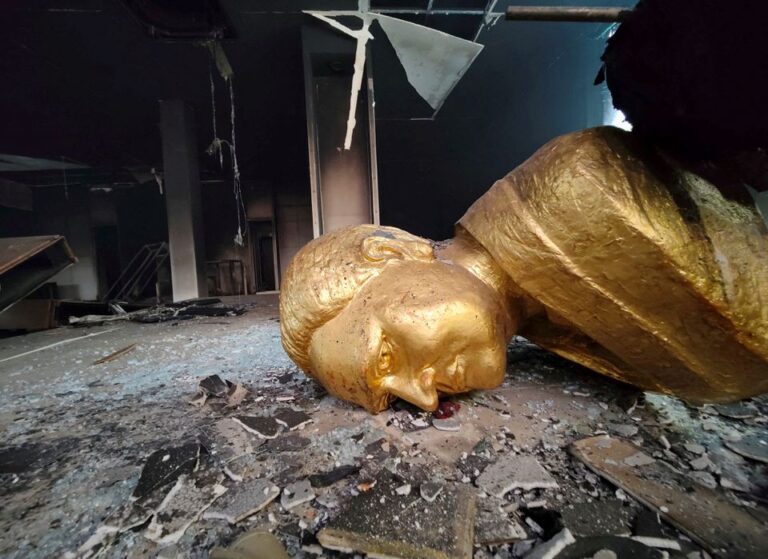
(Reuters) – His beloved villa has been daubed in graffiti by protesters, and a museum dedicated to his father ransacked. Now former Sri Lankan Prime Minister Mahinda Rajapaksa is in hiding in a heavily fortified military base, protected by the armed forces.
The reversal of fortunes for the island nation’s most powerful politician for decades has been giddying. A scion of the Rajapaksa family beloved by many Sri Lankans for ending a protracted civil war, the 76-year-old is now a pariah.
An economic crisis, caused by the COVID-19 pandemic and economic mismanagement, has drained the country of money to pay for fuel, medicine and other vital supplies, meaning lengthy blackouts and long queues for gasoline. Food prices are soaring.
Weeks of largely peaceful demonstrations demanding the prime minister and his younger brother, President Gotabaya Rajapaksa, stand down, turned violent on Monday in the deadliest unrest so far – nine people were killed and over 300 injured.
The turmoil is the worst to hit Sri Lanka since the war ended in 2009. The small southern town of Weeraketiya, where Mahinda liked to stay while visiting the family stronghold of Hambantota district, was not spared.
Shortly after the prime minister resigned on Monday, hundreds of people attacked a small group of police officers guarding his modest villa, vandalising an outhouse containing family memorabilia and sports trophies.
At the main house, graffiti reading “Gota Go Home” – a rallying cry of anti-government protests across the country – has been sprayed on the walls in red.
In Mahinda’s bedroom, windows were smashed but otherwise it looked untouched: television remotes were within reach of a comfortable armchair and a book on Sri Lankan cricketer Muttiah Muralitharan lay nearby.
According to interviews with half a dozen eyewitnesses and police officers, the villa was the first stop on a night of vandalism targeting Rajapaksa properties. No family members were at the residences when they were attacked.
“I have never seen anything like it,” a member of the family’s security detail said, adding that his wounded colleagues did not dare go to hospital to be treated as they feared doctors and nurses would turn against them.
FUTURE IN QUESTION
The worst financial crisis since Sri Lanka’s independence in 1948 has thrown the future of the Rajapaksas into doubt. A family of rural landowners based in Hambantotoa district, the fortunes of the Rajapaksas started flourishing when Mahinda became prime minister in 2004.
After he won the presidential election in 2005, Mahinda and Gotabaya, who defence secretary at the time, ended the civil war with Tamil separatists in the north and east of the country with a brutal government offensive that killed tens of thousands of people.
Mahinda was denied a third term as president in 2015, but the family came back to power in the 2019 presidential election, this time with Gotabaya at the helm.
Two of the nine deaths across the country in Monday’s violence occurred in Weeraketiya, after a crowd attacked the offices of a local lawmaker and his security detail fired on them in response, according to police.
Squads of soldiers and police, who have been given the authority to shoot to prevent looting and damage to public property and when lives are threatened, now guard the vandalised sites.
From the villa, the group proceeded to a museum dedicated to Gotabaya and Mahinda’s late father, parliamentarian D.A. Rajapaksa, where they demolished exhibits and torched the interior.
Little was left when Reuters visited on Wednesday except a golden bust of their father face down on the blackened floor. Houses and shops linked to ruling party lawmakers were also heavily damaged.
Some locals continue to support the Rajapaksa brothers, who are seen as heroes among the island’s Sinhalese Buddhist majority for snuffing out the Tamil insurgency.
Ratnaweera Nandasiri, a 67-year-old paraplegic storekeeper and longtime supporter of the Rajapaksas, said they had provided him with a disability allowance that helped him survive during the pandemic.
On Tuesday evening, he watched as a separate group of around 20 men carrying iron bars destroyed a statue of D.A. Rajapaksa in the nearby town of Tangalle.
From his shop backing on to the memorial garden, he said he remonstrated with the men.






